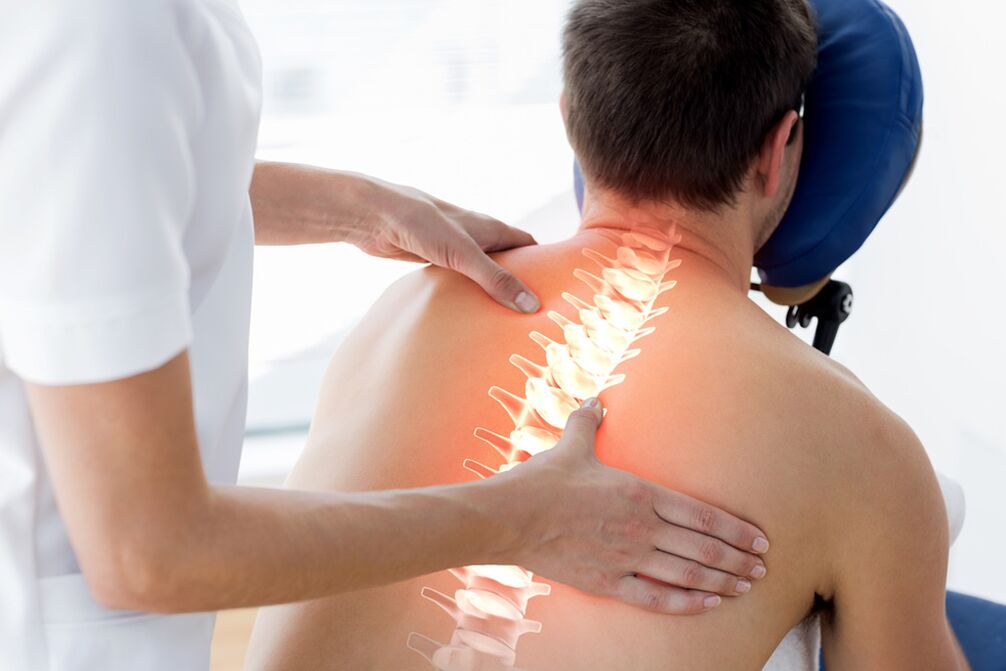Osteochondrosis of the thoracic spine occurs with damage to the intervertebral discs of the thoracic spine. The symptomatology of the disease is similar to the manifestations of cervical and lumbar pathology. Thoracic osteochondrosis is difficult and infrequently diagnosed.

Symptoms of thoracic osteochondrosis in women
The disease is rare in women, as there is less pressure on the thoracic spine than other parts of the spine. Osteochondrosis of the spinal cord is quite difficult to diagnose, as the disease usually manifests itself at the stage of disease development.
The main symptom of thoracic osteochondrosis in women is pain. The pain can usually be localized in the back, sternum, and even radiate to the upper limbs. In addition, a woman may be tormented by pain in the abdomen. The localization of pain depends, first of all, on the stage of the disease course.
Usually, with osteochondrosis of the thoracic spine, a woman feels constant pain, not intense with the nature of the pain. The symptoms of thoracic osteochondrosis also depend on the sensitivity and individual characteristics of the woman’s body.
In the beautiful human half, the symptoms of the disease are more pronounced: the female body is more sensitive, and all parts of the spine are thinner than the male. Degenerative and dystrophic processes in women are more likely to cause negative reactions.
With the defeat of the chest part of the ridge, the fair sex has the following symptoms:
- pain when lifting arms up or when bending;
- pain in the mammary glands;
- discomfort in the sternum, exacerbated by various loads or prolonged stay in an inactive position;
- pain with deep breathing;
- severe pain between shoulder blades in ridge area;
- feeling of pressure in the chest;
- vascular dystonia.
The above symptoms are provoked by processes that take place in the spinal space itself. In the case of the formation of intervertebral hernias, symptoms appear as a result of the development of vascular and neurological pathology.
No less common manifestations in women of thoracic osteochondrosis:
- the appearance of frequent and numb "goosebumps" on the shoulders and arms;
- a burning sensation, chills, or itching in the lower part of the foot;
- pain in the heart area;
- increased fragility of nails, peeling of the skin;
- pathology of the function of the digestive organs: nausea, constipation or diarrhea, bloating.
Since osteochondrosis of the chest occurs with symptoms similar to pneumonia, angina pectoris or cardiac pathology, it is necessary to carry out a differential diagnosis. All of the above manifestations indicate the development of thoracic osteochondrosis. However, you cannot cure it yourself. Only a doctor can make an accurate diagnosis and prescribe effective treatment.
Symptoms of chest osteochondrosis in men
Chest osteochondrosis in men is often diagnosed when there is a high intensive load on the spine (e. g. , the disease is often detected in builders, loaders, etc. ). The clinical manifestations of osteochondrosis in this case occur gradually, while between the ribs and vertebrae there is slow damage to the joints. The earlier the disease is diagnosed, the more effective the treatment.
In the early stages, thoracic osteochondrosis runs without any special manifestations, and the man lives without knowing that his disease is progressing. Any discomfort is usually associated with fatigue that arises after long work, or an uncomfortable posture.
Signs of thoracic osteochondrosis in a man in the early stages:
- as a result of soft tissue compaction, reduced elasticity in the joint area and dryness occurs between the shoulder blades, in the sternum area, the collarbone;
- due to the impaired flexibility of the shoulder girdle, it is difficult to lift the hand and place it on the back;
- discomfort appears in the affected part of the chest;
- after prolonged physical activity or remaining in a static position, there is a feeling of fatigue in the back;
- pain appears with deep breathing.
With the further development of the disease, the following symptoms are observed:
- the pain becomes stronger and persistent. Due to the constant pressure on the nerve endings, pain is observed even at rest;
- there is numbness, tingling sensation in areas with impaired sensitivity;
- there are periodic reflex spasms of the abdominal muscles, proceeding with discomfort;
- a man may be tormented by a false attack of angina pectoris, renal or hepatic colic;
- possible disorders of the pelvic organs, as well as a decrease in potency;
- as a result of the formation of osteochondrosis of the thoracic ridge, irritable bowel syndrome develops - a functional pathology of the digestive organs.
Symptoms of coma sensation in thoracic osteochondrosis
The sensation of coma in the sternum occurs in many patients, but not everyone is concerned about this, because this phenomenon is characterized by a short duration and disappears quickly.
What causes this phenomenon? Usually, the feeling of coma in the sternum occurs as a result of pathology of the nervous system. However, sometimes the cause of this sensation is thoracic osteochondrosis, because in the chest area there are nerve plexuses in large quantities.
As a result of this pathology, intercostal neuralgia often develops. In this condition, the patient has pressure in the back of the chest, and pain also appears, which increases during body movements or when lifting weights. In this case, the pain is similar to a needle puncture and intensifies during breathing.
Osteochondrosis of the thoracic region most often develops due to improper lifestyle, sedentary work, and impaired metabolism. Conservative drug treatment, manual therapy and laser will come to the rescue. Patients are encouraged to enter for sports or fitness.























